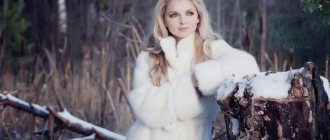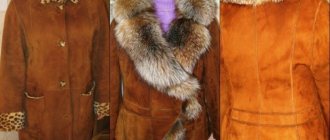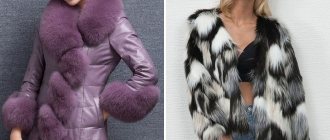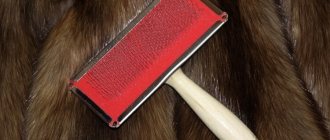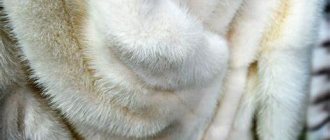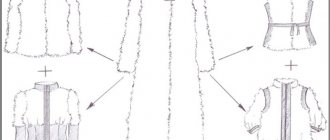Cured skin with natural or dyed leather fabric must be prepared for cutting by slightly moistening it to give the leather fabric
plasticity, i.e. the ability of the skin to take the specified shapes according to the pattern when stretched, and in finished cuts before editing, in order to reduce the effort required when stretching and giving a shape corresponding to the pattern (pattern).
You can moisturize the leather tissue with water, but usually use a solution consisting of sodium chloride (table salt) - 20 g/l, technical glycerin - 20 g/l. The temperature of the solution must be at least 35-40 °C, otherwise the process of liquid absorption slows down, which leads to roughening of the skin, a decrease in its strength and ruptures when straightening the workpiece. At home, the leather tissue is moisturized by rubbing water with a brush or sponge. In this case, the skin is laid with the hair down to prevent moisture from entering. To give the semi-finished product the required humidity (38-40%), an average of 25-40 ml of solution is consumed per nutria skin. Thickened areas are moistened more thoroughly.
Moistened skins are folded in pairs (skin to skin) and stacked. This is necessary for uniform distribution of moisture between the fibers throughout the entire thickness of the leather fabric. The curing lasts no more than 30-40 minutes, otherwise the skins may dry out and become deformed, which will not allow them to be properly straightened and their area increased. In addition, prolonged storage can cause overheating and damage to raw materials.
After curing, the skins are straightened to slightly increase the area. The surface of the leather fabric should be smooth, without folds and wrinkles, so that it is easier to give the configuration necessary for cutting. This is achieved by straightening the moistened skin on a wooden board (linden or aspen) and securing it with special nails (pegs). The skins are straightened from the side of the leather fabric along the length and width, taking into account the details of the product and the shape of the template. When manually straightening, they are stretched from the center to the peripheral areas over the entire area. When straightening the skin on the board, first stretch it across the width in the side parts, fixing it with nails at a distance of 1.5 cm from the edge, then along the length and nail the rump and neck parts to the board (the distance between the nails is 2-3 cm). The workpieces are dried at room temperature or when the air is heated to 40-45 ° C (relative air humidity in both cases is 50%). With the second, more rational method, the drying time is reduced to 30-45 minutes, but after it the skins must be cooled at room temperature for 15-20 minutes and only then removed. from the panels, having previously removed the nails. The skins are folded with the hair inward and the outline of the pattern is drawn with chalk.
Basic rules for stitching fur. The fur is sewn from the inside out with frequent stitches, with a piece seam from right to left (2). Using the index finger of your left hand, carefully tuck the fibers inside. The needle must match the thickness of the membrane so as not to tear it. You can machine stitch it with a zigzag stitch. To do this, you need to fold two pieces of fur with the pile inward, tuck in the hairs and stitch along the very edge of the fur.
Skins
, obtained from sheep of various breeds, as a rule,
are dressed
as
skins
, after trimming, straightening and destination, they are sent for
cutting
.
Open
skins
.
When cutting skins,
a barrel is formed. Furrier's flap includes pieces: from fur sheepskin (sheepskin
dressed
like...
The cutting of
skins
into hats is carried out in specialized teams or on production lines.
Uncover
four
skins
per cut.
It is advisable to collect luggage from skins
.
Natural fur has been used as a material for clothing since ancient times, when harsh weather conditions told our ancestors that the skins of killed animals would be useful for making warm clothes and blankets. More than one millennium has passed, and man has learned to make fur, dye it, bleach it, and tint it. But the main achievement in this area was the tanning of leather and fur.
At the moment, the process of fur dressing is automated, but includes all the same basic processing steps as thousands of years ago. Only despite this, natural fur remains a highly valuable material, and the owners of its expensive types are financially secure and successful people.
Types of fur and their characteristic features
Depending on the type of animal, fur is divided into:
- beaver fur (quite warm and moisture-resistant material);
- otter fur (one of the most wear-resistant);
- raccoon fur (warm and very popular fur, relatively inexpensive);
- marten fur (also warm, hypoallergenic and fairly wear-resistant material);
- ermine fur (very rare, expensive and not the most practical option);
- Karakul (expensive material with unusual colors);
- fox fur (beautiful and practical material);
- seal fur (easy to care for, suitable for very low temperatures);
- mink fur (beautiful, moisture-resistant, practical, rather expensive material: the cost of 1 meter of mink skin is more than 6,000 rubles).
Otter fur is considered the most wear-resistant.
Fur skins have a standard of wearability. Otter fur is considered the most durable and resistant to waterlogging. It is the otter that has the honor of being the standard for all fur-bearing animals, and the fur of fur-bearing animals is compared against it. Even sable fur is inferior to it in strength and wear resistance.
So, if otter fur is 100%, then sable has 80%, mink - 70, arctic fox - 65, astrakhan fur - 60, fox - 50, muskrat - 45, squirrel - 30, ermine and weasel - 25, rabbit - 12, mole and gopher - 10, hare - 5.
Processing natural fur - stretching the material
Now it’s worth addressing the question of how to stretch the skin or process previously prepared fur. To do this, you need to moisten the skin. It is better to do this with a brush or spray bottle. Water quality plays an important role here. It is better if it is distilled, without various impurities of metals, chlorine and other elements.
After this procedure, the skin should lie for about 30 minutes. The exact curing time depends on the thickness and elasticity of the material. It is very important not to allow excess moisture - the fur must remain dry!
Stretching the skins can begin at the moment when the skin is almost dry. Editing should be done in the direction of the pile. The skin is straightened and pinned to the board with nails or safety pins. When stretching, try not to damage the structure of the skin and hair. If the pile is long, then such material is attached with the fur facing up, and if it is short or of medium length, then the fur is attached to the board.
The material should be stretched strictly in a certain sequence: first prick the bottom of the product, then the middle, then evenly stretch it to the left and right from the center and diagonally from the bottom up to the edges. After finishing stretching, leave the product to dry completely. On average, this time is about a day. Then remove the skin and leave it for at least 2 hours to cure. It should be noted here that the more the wet material is stretched, the more it will shrink. Having finished talking about how to stretch the skin, you can proceed to other processing methods.
How to store warm clothes
Out of season, warm clothes need to be stored properly. When a product is made of natural fur or has fur inserts, it is necessary to leave the item cool - a balcony closet with tight-fitting doors is the best option. In this case, the clothes are wrapped in vacuum bags - they should not come into contact with other things and should be protected from direct sunlight.
For reference!
It is not recommended to store genuine leather products on a balcony/loggia.
Hats, especially those that keep their shape, should be stored in cardboard boxes. Scarves made of silk, acrylic, and thin fabric are placed on special hangers for storage. Cashmere and wool scarves are folded and placed in a drawer - this will prevent the item from stretching during storage. With sweaters, do the same as with wool scarves. However, it is prohibited to stack long woolen and leather items - they must be placed on hangers with soft hangers.
Fur processing - fatting
Fattening is necessary only if the elasticity of the skin is reduced, then work with fur begins. To eliminate dryness of the skin tissue after the drying stage, before removing the stretch, you should wipe the material with a cotton swab or a small piece of cloth soaked in glycerin. After this, leave the skin until the glycerin is completely absorbed, and only then remove it from the stretch. This procedure will prepare the skin for cutting, making it soft and elastic.
Then you can remove the material from the board, comb the fur and start cutting. Wavy edges should be straightened immediately.
Fur color
If natural fur is very dirty, it should be cleaned before coloring, since the dye does not penetrate well into the contaminated hair structure. To do this, take an alkaline solution.
- 2-3 tsp. salt;
- 1 tsp. ammonia;
- 1 tsp. detergent;
- 2 tsp. baking soda;
- 1 liter of water.
When coloring, the underbelly should be treated with glycerin or a rich cream should be applied to avoid it from drying out.
Fur pelts are usually dyed darker colors. When dyeing a lighter color, you will first need to lighten your hair using hydrogen peroxide.
Fur is dyed by placing the skin on a wooden board and securing it with pins or small nails. Use ordinary hair dye for this. Before the procedure, the fur can be slightly wetted to make it easier to distribute the paint. Exposure time - according to the instructions on the package. We wash off the paint without removing the skin from the board in the shower, then dry it and lift the fur with a hairdryer. It will take the most time to dry the flesh.
Popular leather dressing recipes
The fermentation procedure is considered a classic option for tanning hides, after which the material becomes strong and elastic. Alum for tanning hides is prepared according to different recipes, using ingredients of natural and artificial origin - flour, malt, rock salt, soda, acids, fermented milk products. The acid pickling procedure is an alternative to traditional fermentation. To prepare pickel, acetic acid, salt and water are usually used. Instead of vinegar, you can use sulfuric or boric acid.
Dressing must be done with fresh skin. If the work needs to be postponed, then the skin can be salted, generously rubbed with salt, frozen or dried.
Recipe for tanning skins at home:
- If the skin is dried, then it is first necessary to unwind it, that is, soak it in a special solution (1 liter of water + 1 tablespoon of salt + ½ tablet of furatsilin + ½ teaspoon of vinegar). The skin must be completely placed in the solution, so it is placed under pressure.
- The moistened skin is squeezed out, stretched and flayed according to all the rules. Next, you need to wash it to finally get rid of grease and dirt. One of the popular recipes for detergent is 6 liters of water + 3 tablespoons of dishwashing liquid + 2 tbsp. spoons of rock salt + 1 teaspoon of soda. Wash with force, then rinse the skins thoroughly until the water is absolutely clean.
- For pickling, it is recommended to prepare a solution using 3 liters of water, 6 level tablespoons of salt and 1 tablespoon of vinegar essence. The skin is kept in the pikelet for several hours, then it is squeezed out and tanned.
- Tanning agent recipe - water, oak bark, 4-5 tablespoons of salt. Everything is mixed, the liquid is brought to a boil and cooked for 20-30 minutes. The finished solution is filtered, cooled to 35-38° and the skin is soaked in it for 6-9 hours in a row.
- After tanning, the liquid is squeezed out of the skin and the fur is dried. The dried skin is treated with a fat emulsion prepared from hot water, laundry soap, salt, natural fat (pork, fish, lamb) and ammonia.
- You should remove the remaining fat solution from the surface of the skin, stretch the skin on plywood and wait for it to dry. The dried skin is removed from the stretch and kneaded, that is, it is gradually rubbed between the fingers. Finally, the core can be polished with a scraper or pumice.
Dressing leather and fur is a complex, time-consuming and labor-intensive procedure. You can achieve mastery in the leather and fur business only by working and studying. Years of experience result in light, soft and flexible skins that look great, feel great and have a long service life.
An easy way to tan hides - video
Tanning hides
During the drying process and other procedures, the hide is subjected to mechanical processing, as a result of which the material becomes brittle and hard. Tanning helps strengthen the structure of the skin of mink, otter, raccoon, marten and other animals, which occurs due to the penetration of tanning substances into the skin, which bind protein fibers. After this procedure, the skin remains plastic and soft, and its resistance to decay and the influence of high temperatures increases. The material also withstands repeated exposure to water, painting and subsequent drying.
Tanning can be done either using chemicals or natural tanning agents of vegetable origin.
Let's consider one of the tanning methods. To do this, you will need a half-liter jar of oak bark, which can be purchased at the pharmacy. Fill it with two cans of water and bring to a boil, then boil for 10-15 minutes and leave to infuse for a day. Then the broth is filtered and applied cold with a brush to the skin from the inner side and dried on spacers. During the drying process, knead slightly.
Wear resistance of fur
An important indicator of the quality of fur is its wearability. Otter fur is considered the most wear-resistant. Products made from it will last 20 seasons without any restoration. In second place in terms of wearability is beaver fur, and in third place is fur seal. Products made from the most popular and desirable types of fur - sable, mink and arctic fox - will last 12, 9 and 7 seasons, respectively. The least likely to be worn are the fur of a hare (1 season), long-haired rabbit (2 seasons) and marmot fur (3.5 seasons). You can also touch more deeply on the topic of wear resistance of some types and talk about how to process rabbit skins, but this is a different matter.
Fur wear resistance indicators:
- hair strength;
- core strength;
- bond strength between hair and leather tissue;
- thickness and density of the skin;
- thickness of the epidermis and subcutaneous tissue;
- hair density, etc.
In turn, for example, the strength of the bond between the hair and the flesh depends on the type of fur, the season of production, and also on compliance with the technology for processing the skins. Thus, during the molting period, the connection between the hair and the skin is minimal, so fur should be harvested in late autumn. During this period, the skin has the best characteristics.
How to sew fur skins on a furrier machine
Fur skins are sewn together either by hand or using a furrier's machine. To make a furrier's seam on a machine, the skin at the seam is folded with the hairs facing each other, carefully tucked the hair inward with the index finger or an awl, and the edges of the skin are sewn together. The stitch height and width are adjustable.
The thickness of the needle and thread should correspond to the thickness of the leather fabric. Choose the color of the threads not to match the color of the fur, but to the color of the leather fabric, then they will be less noticeable on the front side of the skin. When working on a furrier's machine, you should carefully tuck the hair between the skins, since the furrier's machine will “put” hair into the seam, which will be very difficult to pull out. In addition, this can lead to malfunction of the furrier’s machine, skipping stitches, breaking the needle, etc.
For arctic fox and fox skins, use thread No. 80, for thin rabbit skins - No. 50, 60, for other skins - No. 40, 50. After joining, furrier's seams are smoothed with the butt of a shoemaker's knife or with light blows of a hammer with a rubber sole.
You can cut fur only with a special shoe knife on the back side of the fur laid out on a plastic board or plexiglass. It is inconvenient to cut with a knife on a wooden surface; the tip of the knife will constantly cut into the boards. If you cut off a fur skin with scissors, some of the fur will fall off on both sides, and when joined, the seam will be very noticeable.
I advise beginning furriers to first work with old fur that has not yet lost its aesthetic qualities. In addition, such fur can be slightly updated if you combine it with genuine leather and install new accessories.
In this video you will see how a furrier machine works. We sew together two small pieces of fur especially for you.
How to distinguish a fake?
There are often cases when natural fur is counterfeited with cheaper material. For example, after giving the appropriate appearance, a marten is passed off as a sable, a nutria is passed off as a beaver, and a mink is often replaced with a rabbit or marmot.
In order to recognize a substitution, you need to pay attention to the fur. The beaver, for example, has longer guard hairs than the nutria, and the undercoat is thicker. The spine of rabbit fur is much softer than that of mink. And the marmot's fur is of different lengths, unlike the mink, which has perfectly even hair.
How to define quality?
Before you deal with the question of how to stretch the flesh, you need to find out what it is and why stretching is necessary.
The mezdra is the layer of subcutaneous tissue in the skin of an animal; it is, so to speak, the “leather part” of the fur coat. The service life of the product and its appearance will depend on the quality of its workmanship. The main evaluation parameters are the strength of the flesh, its thickness, color and elasticity, which depends on the amount of fat remaining after processing.
If the skin was too degreased during the preparation process, then when crumpled it will make a characteristic rustling sound, like parchment paper. This can be fixed, but you need to know how to soften the flesh. And if there is too much fat left, the leather part will look greasy and shiny; products made from such material run the risk of acquiring a sharp, characteristic smell of old lard over time.
High-quality leather has a tan leather fabric of a pleasant light beige color, is quite flexible and has a looser structure than suede.
Why does the hat shrink?
To obtain suitable material for the manufacture of headwear, the raw materials must go through many complex processing steps. This is the only way to obtain matter that will have the necessary characteristics - density, thickness and softness. But even pre-processing of raw materials is unable to completely eliminate the likelihood of cap deformation. Most often, woolen products, fur and leather hats lose their shape and shrink due to the following circumstances:
- Violation of the washing/cleaning temperature regime. This is one of the common problems. Natural materials of animal origin contain keratin, a natural protein that coagulates due to heat. Accordingly, matter is compressed.
- Hard rinse. A wool hat may rub against the drum during the rinse cycle in the washing machine. The result is matted fibers.
- Incorrectly selected washing chemicals. Lye, present in many detergents, weakens the structure of natural matter.
- Features of the cap material production process. During the processing of raw materials, the material is stretched. After the first contact with water, the product may shrink.
- Insufficient quality of material. If the production process is disrupted, it is virtually impossible to maintain the original appearance of the hat, even with careful care.
- Violations of the rules for drying hats. An incorrectly chosen method or a temperature jump caused it to shrink after washing, rain, or snow.
Attention!
It is possible to restore the size of the headdress with your own hands. There are many options that allow you to stretch a shrunken hat as painlessly as possible for the product. The main thing is to be careful, follow the rules exactly and not neglect the recommendations.
Common damage
Oddly enough, people who are trying to figure out what “correct fur” looks like do it from a photograph. One of the so-called standards in this matter is mink flesh, photos of which can be found very often. However, it is very difficult to judge the quality from the image; for this you need to see the real color, smell, touch it with your hands, and listen to your feelings.
The most common defects are fur flow and stitching. The first, for example, is due to the fact that the hair follicles of some animals are not located in the flesh, but much deeper. After the skin has been removed, the hair loses its base and begins to fall off. If you pull the fur and a couple of hairs remain in your hands, do it again - as long as the “molting” stops the second or third time, everything is fine. Once you comb your fur coat thoroughly, the problem will disappear. But if each time you have more and more hairs in your hand, then the problem is quite serious, and it is called stitching. Here is the result of the work of a cross-haired fur master who cut off too much of the flesh along with the bulbs from which the hair grows.
After such shaving, the hairs simply have nothing to hold onto, and the fur falls off en masse. It is almost impossible to stop this process; we can safely say that the life of such a product is very short.
Recovery methods
If you are still “lucky” to purchase fur of dubious quality, and you no longer have the funds left to contact a professional furrier, you can try to revive the skin yourself. Of course, for this you need to know how to restore the flesh. If the leather part of the hide has dried out and become rough, try lubricating it with the following composition:
- 1 liter of warm water;
- 1 g of ammonia;
- 50 g pork fat.
All ingredients should be thoroughly mixed, applied to the core, cleaned of dust and dirt, and left for 30–40 minutes to soak. Next, you should repeat the procedure several times with a break of 2-3 hours, then dry the fur, gently knead it with your hands and lubricate the skin layer with the following composition:
- 1 liter of water at room temperature;
- 5–6 drops of ammonia;
- 100 g each of soap and castor oil.
After this, fold the skin inside out and leave for 4–5 hours, and then dry it unfolded at room temperature.
Why stretch the skins?
If you decide to buy a fur coat, and the seller assures you that it is made from whole, unstretched skins, feel free to walk away - you are being blatantly deceived.
To make the product beautiful and of high quality, there is no other way than to stretch the core. Why? Imagine any animal - it is unlikely that in nature you will find such an individual whose head is the same size as its back. Therefore, any natural skin has the shape of a trapezoid, moreover, uneven at the edges. It is not possible to sew such skins together, much less make a fur product from them. In addition, untreated skin easily stretches in all directions, and even if you manage to sew a fur coat, then after the first wear in all “strategic” places: shoulders, elbows, on the chest and, excuse me, below the back, bubbles and stretch marks will remain, as in old "sweatpants". It is unlikely that anyone will like to wear such fur.
The essence of the process
Before stretching the mesh, it is carefully moistened so as not to soak the fur. Then the skin is straightened and stretched by hand until it stops deforming, secured to a hard surface using furniture clips or small nails and left in this state to dry. If necessary, this procedure is repeated several times until the desired result is achieved.
Well, we’ve figured out a little how to stretch the flesh, and now let’s get acquainted with the most common solutions for wetting, since it is highly undesirable to use water. You also need to strictly observe the temperature of the solution; if it is less than 35˚C, the solution will be absorbed too slowly; at a t˚C of more than 40 degrees, the skin may “cook”. So, one of the solutions will help soften the flesh at home:
- Dilute 50 g of alcohol in one liter of water, 1 tsp. glycerin and table salt;
- Dissolve 20 g of salt and glycerin in a liter of water and add 3 g of potassium alum (this solution is suitable for any skin except squirrel skin).
How to stretch wool clothes
When a woolen item has shrunk, two methods are used to stretch it - physical and chemical. The first method is to pull the wet wool product out by hand or using an iron/steamer. The chemical option is the use of specialized products. The best results are obtained when physical and chemical methods are combined.
Chemical technique
To return woolen clothes to their original size, use 4 products that are practically always at hand - hydrogen peroxide, table vinegar, wool conditioner and hair conditioner. A tablespoon of hydrogen peroxide or table vinegar for stretching is dissolved in 5 liters of water. The woolen item is soaked in this solution for 5-30 minutes. Then the clothes are rinsed. Wool conditioner is used as follows:
- dilute according to the instructions for the product;
- soak the shrunken item in the solution for 5-10 minutes;
- wring out the woolen product with a towel;
- Lay out the clothes on a horizontal plane to dry.
Hair conditioner is highly effective when you need to stretch out shrunken woolen items. The effect of the product is similar to a specialized wool conditioner, since their compositions include similar components. To stretch the wool you need 1 tbsp. dissolve hair conditioner in 5 liters of water. Clothes are left in the liquid for 30 minutes. Then they take it out and wrap it in a towel.
For reference!
There is no need to rinse hair conditioner on wool products.
Physical technique
By manually pulling and fixing the product in the desired position during drying, the result of exposure to chemicals is secured. The main thing is to ensure that the item does not lose its symmetry, since after drying the clothes will retain it. There are 3 ways to restore the original size of products made from woolen fabric and yarn after the clothes have shrunk:
- Using a towel instead of wringing. The item is lowered into the water, the towel is spread over a flat surface. The clothes are stretched by hand, placed on top of the towel and wrapped in a roll for 10 minutes. – terry cloth will absorb moisture. Then the towel is replaced and the procedure is repeated.
- Ironing helps when clothes are dry but have shrunk slightly. The item is straightened on the ironing board. The product is covered with a damp towel and ironed without pressing, but with slight stretching in the desired directions.
- Putting on and wearing a wet item until it dries or attaching the item to a mannequin.
There is a separate way to stretch a knitted hat - lower the headdress for 10 minutes. into water with conditioner, then wring out. After the excess moisture has been removed, the hat is placed on a suitable ball or jar and left to dry. The result will be a hat that matches the size of the object that was used as a block.
Some more recipes
If you still decide to stretch the membrane yourself, then you can use the following solution:
- 100 g salt + 70 g egg yolk + 25 g glycerin. All this should be dissolved in one liter of water, carefully applied to the flesh and left to soak.
For squirrels you can use the following solution:
- 1 liter of water with a temperature of 40˚C (carefully, not higher);
- 75 g wholemeal oatmeal;
- stir and leave for a day, then add 30 g of table salt.
The smell of this solution, of course, is not very good, but the result is worth it. As you can see, this procedure is not too complicated, but quite troublesome. Unfortunately, if the flesh is very dry as a result of improper processing and storage, it is unlikely that it will be possible to return its absolute softness. But it's worth a try, right?
How not to spoil woolen items
In order not to spoil woolen items, it is necessary to adhere to the rules of precaution in handling and storage. The first thing you need to do is read the manufacturer’s recommendations written on the labels. Signs on the labels indicate how the item can be washed, whether it is permissible to iron it, and other significant points that describe the possibility of using certain types of chemicals, etc. In addition to the manufacturer's recommendations, the following rules must be followed:
- Expensive and comfortable items made of woolen fabric are recommended to be washed by hand using detergents marked “For wool”. Machine washable only with cold water in a gentle cycle without spinning.
- To prevent deformation of hats after washing, it is prohibited to wring out the hats.
- It is necessary to avoid drying wool products on clotheslines and near heating appliances. Woolen items should dry on their own on a horizontal surface in a straightened position.
- It is prohibited to use hot steaming when ironing wool.
By following the rules for handling things made from natural materials, it is possible to keep their appearance unchanged. But sometimes wool, fur or leather hats suffer due to unforeseen circumstances. In such cases, it is better to seek help from ateliers and workshops. But, in emergency situations, it is possible to stretch the headdress yourself, provided you follow the process technique.
How do you like the article?
